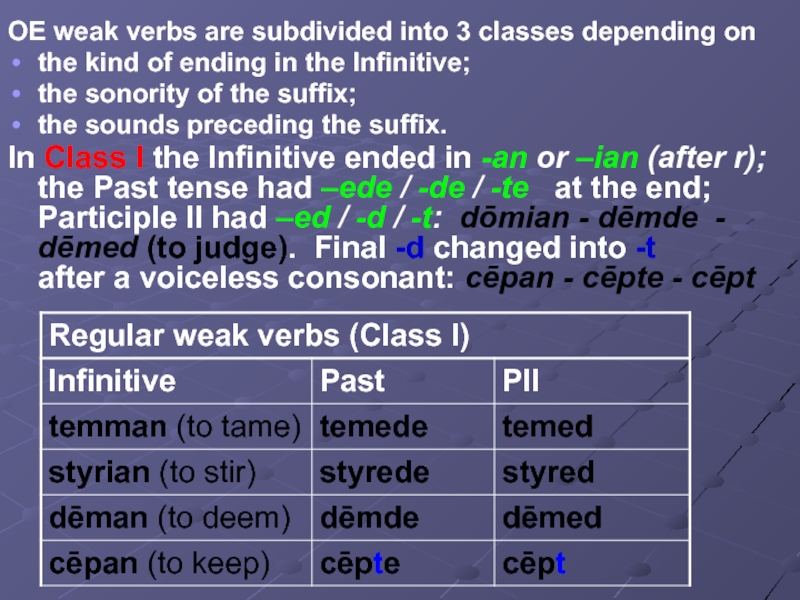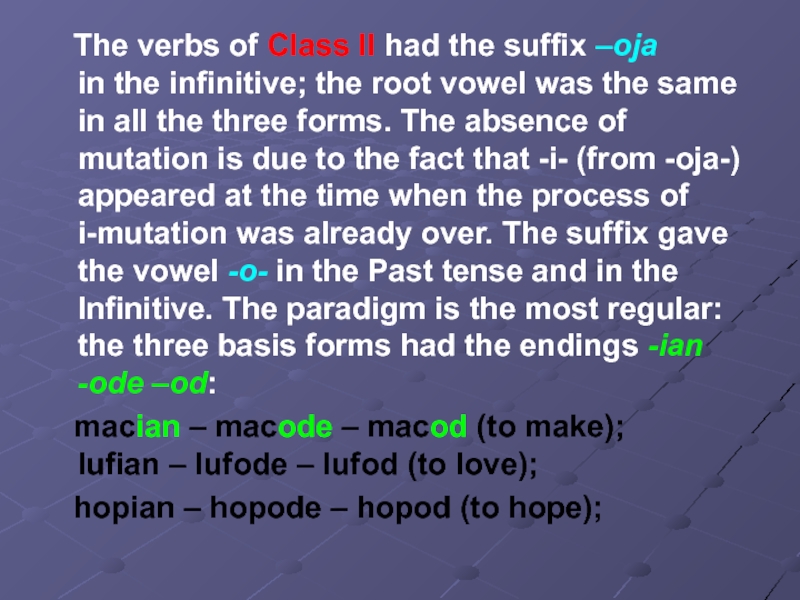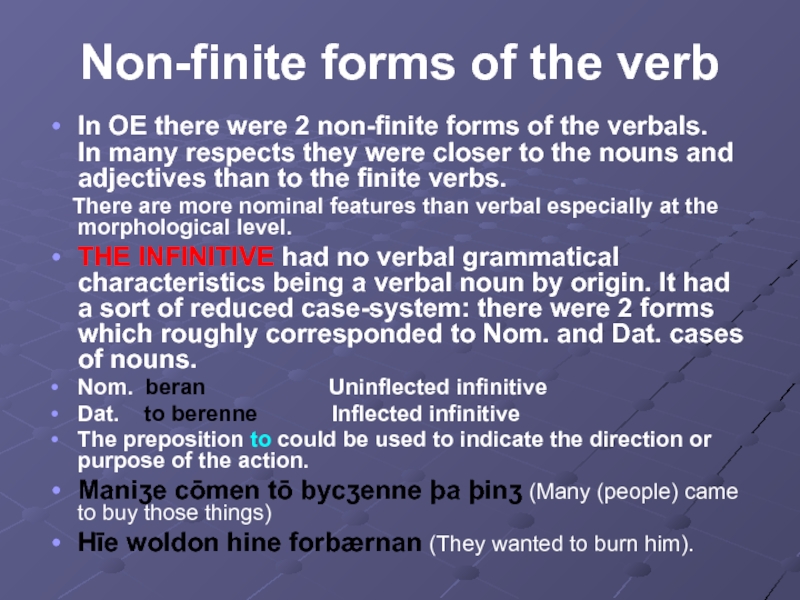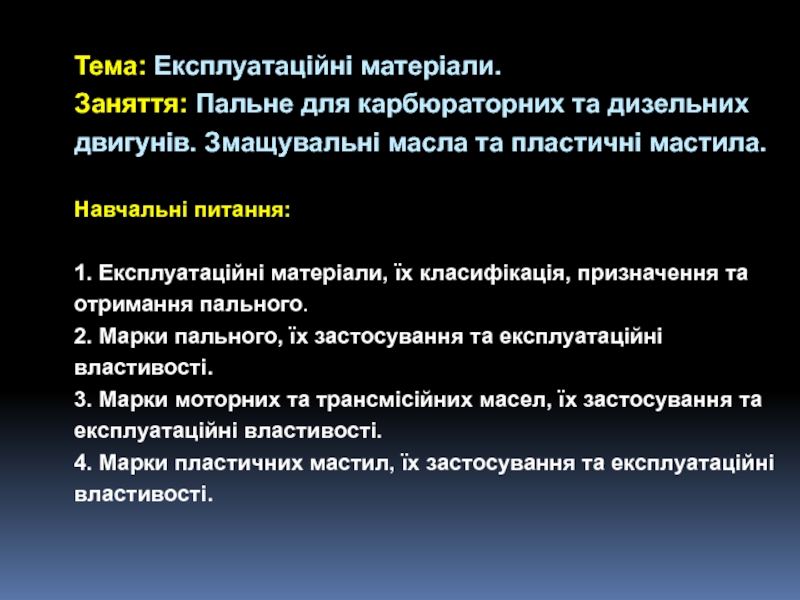Разделы презентаций
- Разное
- Английский язык
- Астрономия
- Алгебра
- Биология
- География
- Геометрия
- Детские презентации
- Информатика
- История
- Литература
- Математика
- Медицина
- Менеджмент
- Музыка
- МХК
- Немецкий язык
- ОБЖ
- Обществознание
- Окружающий мир
- Педагогика
- Русский язык
- Технология
- Физика
- Философия
- Химия
- Шаблоны, картинки для презентаций
- Экология
- Экономика
- Юриспруденция
KYIV NATIONAL LINGUISTIC UNIVERSITY
Содержание
- 1. KYIV NATIONAL LINGUISTIC UNIVERSITY
- 2. PlanGrammatical Categories of the finite forms of
- 3. LiteratureРасторгуева Т.А. История английского языка. – М.:
- 4. Grammatical Categories of
- 5. The finite forms of the Verb had
- 6. The category of Tense was represented only
- 7. The majority of verb forms are active
- 8. There was no category of Voice in
- 9. There were three moods: Indicative, Imperative and
- 10. Morphological classification of verbs in OE. All
- 11. Слайд 11
- 12. The four basic forms of every strong
- 13. The interchange between [e] and [o] was
- 14. The question may arise why the so
- 15. Thus strong verbs may be called “ablaut
- 16. The strong verbs in OE are divided into 7 classes acc. to the ablaut line
- 17. Some forms of verbs belonging to different
- 18. Weak verbs. Whereas strong verbs used ablaut
- 19. OE weak verbs are subdivided into 3
- 20. The verbs of Class I could be
- 21. The verbs of Class II
- 22. The verbs of Class III
- 23. Preterite-Present Verbs These verbs
- 24. The past (preterite) of these verbs became
- 25. Preterite-present verbs combine the qualities of the
- 26. Anomalous verbs. There are four
- 27. Слайд 27
- 28. Conjugation of
- 29. Слайд 29
- 30. Слайд 30
- 31. Non-finite forms of the verb In OE
- 32. THE PARTICIPLE was a kind of verbal
- 33. The forms of the two
- 34. THANK YOU FOR YOUR ATTENTION!
- 35. Скачать презентанцию
PlanGrammatical Categories of the finite forms of the OE Verb.Morphological classification of verbsStrong verbs.Weak verbs.Preterite-present and irregular verbsConjugation of Verbs.Non-finite forms of the verb.
Слайды и текст этой презентации
Слайд 1KYIV NATIONAL LINGUISTIC UNIVERSITY
Subota S.V.
LECTURE 4
OLD ENGLISH GRAMMAR.
THE VERBAL SYSTEM.
Слайд 2Plan
Grammatical Categories of the finite forms of the OE Verb.
Morphological
classification of verbs
Strong verbs.
Weak verbs.
Preterite-present and irregular verbs
Conjugation of Verbs.
Non-finite
forms of the verb.Слайд 3Literature
Расторгуева Т.А. История английского языка. – М.: Астрель, 2005. –
С. 108-124.
Ильиш Б.А. История английского языка. – Л.: Просвещение, 1972.
– С. 87-110.Иванова И.П., Чахоян Л.П. История английского языка. – М.: Высшая школа, 1976. – С.135-153.
Студенець Г.І. Історія англійської мови в таблицях. - К.: КДЛУ, 1998. – Tables 47-53
Слайд 4Grammatical Categories of
the finite forms of the
OE Verb.The system of the OE verb was rather developed though less complicated than it is to-day. The main form-building means were synthetic: suffixation (endings), gradation (ablaut, vowel interchange) and suppletion (suppletive formations). Some of them could be combined.
The forms of verbs could be finite (changeable in accordance with grammatical categories) and non-finite. Non-finite forms existing in OE are: the Verbal Noun, the Infinitive, Participle I and Participle II.
Слайд 5The finite forms of the Verb had the categories of
Person, Number, Tense and Mood.
The category of Person was
based on the opposition of three persons: the first, the second and the third, which were grammatically marked only in the singular. There were no person distinctions in the plural. There were two numbers – the singular and the plural. Dual pronouns took the plural forms of verbs.
Слайд 6The category of Tense was represented only by two opposite
members – the Present and the Past.
Present PastIndicative Ic wrīte Ic wrāt
Oblique Ic wrīte Ic wrīte
There was no Future tense in OE, future events were expressed with the help of a present tense verb + an adverb denoting future or by a combination of a modal verb: sculan (shall) or willan (will) + an infinitive.
Ic lufiʒe tō dæʒ oððe tō merʒen.
(I will fall in love today or tomorrow)
Wille ic asecʒan mærum þeodne min ærende.
(I want to tell the glorious prince my permission)
Слайд 7The majority of verb forms are active
in meaning. The passive meaning is rendered through
the combination of the verbsbēon (to be), wesan or weorðan (to become) + Participle II:
Hīe wæron micle swiþor ʒebrocede on þæm þrīm ʒearum.
(They were badly afflicted in these 3 years)
Слайд 8There was no category of Voice in OE.
The only “passive” form (mediopassive) which
existed in OE was the form of the verb hātan (to call, to be named).Þā ēa þe hātte Araxis (the river that is called Arax)
Þā dēor hie hātaþ hrānas (the deer they called reindeer)
One verb is not enough to speak about the category. The sentences with the verbs bēon, weorðan and Participle II were still free word-combinations and not yet analytical formations.
They will become as such at the end of OE and beginning of ME, when the endings become reduced and the auxiliaries lose their lexical meaning.
Слайд 9There were three moods: Indicative, Imperative and Oblique.
Indicative Imperative Oblique
Þu cepst cēp cēpeThe Indicative Mood and the Imperative Mood were used in cases similar to those in which they are used now. But the Oblique Mood in OE differed greatly from the corresponding mood in PDE.
There was only one mood form in OE that was used both to express events that are thought as unreal and as problematic.
Слайд 10Morphological classification of verbs in OE.
All the OE finite
verbs can be subdivided into four groups according to the
grammatical means with the help of which they built their basic forms: two major – strong and weak and two minor – preterite-present and anomalous (sometimes called suppletive).Strong verbs built their forms by means of vowel gradation and by adding certain inflections and suffixes. Among all the paradigmatic forms of strong verbs there are four basic forms: 1) the Infinitive 2) the Past singular 3) the Past Plural and 4) Participle II.
1 2 3 4
OE wrītan – wrāt – writon – writen (to write)
Слайд 11 1
2
3 4OE wrītan – wrāt – writon – writen (to write)
The forms are basic because they are at the basis of other (not basic) forms.
1) The stem with the vowel which is used in the Infinitive is used also in the Present Indicative, the Present Subjunctive, the Imperative Mood and Participle I;
2) the second stem is used to form the 1st and the 3rd persons singular of the Past Indicative;
3) the stem of the third basic form helps to build the 2nd person singular and the plural of the Past Indicative and also the forms of the Past Subjunctive (Conjunctive);
4) the stem of Participle II forms only itself.
Слайд 12The four basic forms of every strong verb create
a chain of four alternating
vowels responsible for a specific form in the line. The OE alternation of vowels goes back to the original IE alternation which differentiated the forms of the verb. The scholars called it Ablaut (in German the word means “the interchange of sounds”). Ablaut (Vowel gradation), an independent vowel interchange unconnected with any phonetic conditions: different vowels appear in the same environment, surrounded by the same sounds. The IE Ablaut involved only vowels [e] and [o], which could be short or long. These vowels alternated with each other and also with the zero position.E.g. Ukr. нести – ноша Rus. беру – сбор – брал
Слайд 13The interchange between [e] and [o] was called qualitative (якісне
чергування), Rus. бреду – брод the interchange between short and
long vowels E.g. Lat. sedo – sēdi (to sit - sat) or one of them with the zero position was considered quantitative (кількісне чергування) Rus. беру – сбор – бралAlternation made it possible to express different aspects of actions. It is supposed (on the basis of comparative analysis of IE languages) that PIE did not have tenses but only aspects, on the basis of which different tenses developed later.
Слайд 14The question may arise why the so simple system of
IE ablaut became so complicated in OE. The matter is
that the vowels which took part in the ablaut (ablaut vowels) underwent different changes since the IE period, and it is even possible to determine the steps of them. Some changes of vowels took place in CG (such as CG Vowel shift, CG Fracture etc.); some other phonetic changes took place already in OE.PIE [o] – [o:]
PG [a] – [o:] OE faran – fōr (to go)
Слайд 15Thus strong verbs may be called “ablaut verbs”,
the verbs which have the alternation
of vowels in the stems. The ablaut lines vary and it is the kind of ablaut series which made it possible to distribute all strong verbs into 7 classes. The first five classes in PIE are based on the ablaut “chains” which are characterized by qualitative ablaut ([e] – [o] – [-] – [-]), in the sixth class the original gradation was purely quantitative ([o] – [o:] – [o:] – [o]) , but in PG it changed into a quantitative-qualitative series ([a] – [o:] – [o:] – [a]). The seventh class is based on the reduplication of the root – the verbs built their past tense by repeating the rootGoth. haitan – haihait – haihaitun – haitans (to call)
In OE we have only the relicts of this process: the roots in the past tense stems had been contracted and appeared as a single syllable with a long vowel
OE hatan – hēt (heht) – hēton (hehton) – hāten (to call)
Слайд 17Some forms of verbs belonging to different classes, if they
had a fricative in the root, had in their forms
the interchange of consonants under Verner’s Law (voicing of fricatives):cēosan - cēas – curon – coren (to choose, Class II);
sniðan – snāþ – snidon – sniden (to cut, Class I);
cweðan – cwæþ – cwædon – cweden (to say, Class V);
in case of - s the latter changed into -r (due to rhotacism). These changes are often called “grammatical” Verner’s Law.
Слайд 18Weak verbs. Whereas strong verbs used ablaut (vowel interchange) as
a means of differentiation among the basic forms, weak verbs
used for that purpose suffixation. Weak verbs formed their Past and Participle II by means of the dental suffix -d- or -t-. This way of building grammatical forms is considered to be a purely Germanic phenomenon. It is found only in Germanic languages.The origin of the dental suffix is a disputable question. Some scholars trace it back to the Past tense of the verb dōn. Some consider that it originated from the suffix of Participle II.
Weak verbs are considered to have only three basic forms.
E.g. lōcian – lōcode – lōcod (to look)
Слайд 19OE weak verbs are subdivided into 3 classes depending on
the kind of ending in the Infinitive;
the sonority of
the suffix; the sounds preceding the suffix.
In Class I the Infinitive ended in -an or –ian (after r); the Past tense had –ede / -de / -te at the end; Participle II had –ed / -d / -t: dōmian - dēmde - dēmed (to judge). Final -d changed into -t after a voiceless consonant: cēpan - cēpte - cēpt
Слайд 20The verbs of Class I could be regular and irregular.
The Infinitive of the irregular verbs had mutated root-vowel, while
in the Past tense and in Participle II the vowel remained unchanged. Thus they had different vowels in the root of the 1st form as against the 2nd and the 3rd: sellan – sealde – seald (to give). The vowel interchange was caused by -j in the stem in accordance with assimilative i-Umlaut. Ablaut, in its turn, is not assimilative, but spontaneous and independent. Goth. saljan OE*salian > sellan (to give) – I-Umlaut
salida OE*salde > sealde (gave) – OE Breaking
Слайд 21 The verbs of Class II had the suffix
–oja in the
infinitive; the root vowel was the same in all the three forms. The absence of mutation is due to the fact that -i- (from -oja-) appeared at the time when the process of i-mutation was already over. The suffix gave the vowel -o- in the Past tense and in the Infinitive. The paradigm is the most regular: the three basis forms had the endings -ian -ode –od:macian – macode – macod (to make); lufian – lufode – lufod (to love);
hopian – hopode – hopod (to hope);
Слайд 22 The verbs of Class III had the suffix
-ai-, which is no longer found in OE. This class
is not numerous and has a tendency to disintegration:some of the verbs pass into the 1st or the 2nd class. The most frequent verbs in this class are:
habban – hæfde – hæfd (to have);
libban – lifde – lifd (to live); secʒ(e)an – sæʒde – sæʒd (to say).
The verbs have doubled consonant in the Infinitive and the mutation of the root vowel caused by –i / j- in the suffix and the endings of the forms: -an / -de / -d.
Слайд 23 Preterite-Present Verbs
These verbs are of
specific character in the verb system of OE.
There were 12 preterite-present verbs: wītan (know), āʒan (have), duʒan (be useful), unnan (presént), cunnan (know), ðurfan (need), durran (dare), sculan (shall, be obliged), munan (remember), maʒan (may), ʒeneah (past sing. sufficed), mōtan (may). Originally (before the CG period) these verbs were strong and each belonged to a corresponding strong class in accordance with its ablaut series (line)
Слайд 24The past (preterite) of these verbs became present, and they
got the name of “preterite-present” verbs. So these verbs appeared
not to have the past form. Thus, to render the past, the “new” form of past was built in accordance with the pattern of weak verbs, that is, with the help of the dental suffix. Hence the preterite-present verbs appeared to be of mixed type: they had the past of former strong verbs with the present meaning and a new “weak” past form.Слайд 25Preterite-present verbs combine the qualities of the strong verbs as
well as the weak verbs. Their Present tense is formed
according to the rules of formation of the past tense of the strong verbs (vowel gradation), while their Past tense has the peculiarities of the weak verbs (a dental suffix).Слайд 26 Anomalous verbs. There are four verbs in OE
which are sometimes named irregular. To avoid associations with modern
irregular (non-standard) verbs, we prefer the term “anomalous”. Two of them are suppletive (the forms of which are based on different roots): bēon / wesan (to be) and ʒan (to go); and two verbs are with irregular paradigms: dōn and willan. The paradigms of these verbs contain many individual forms because they go back to the time when “abstract” grammar was not enough developed.Слайд 28 Conjugation of Verbs
The verb conjugation
in OE.
The paradigm of the OE verb includes a little bit more than 30 positions (less than theoretically possible); in addition, many forms were fully or partially homonymous. Practically speaking there were about ten endings which marked different grammatical categories. Thus each marker was used for some categories: e. g.: the ending -e could be found in 9 positions, -en – in 5 positions, -að in 4 positions etc.Слайд 31Non-finite forms of the verb
In OE there were 2
non-finite forms of the verbals. In
many respects they were closer to the nouns and adjectives than to the finite verbs.There are more nominal features than verbal especially at the morphological level.
THE INFINITIVE had no verbal grammatical characteristics being a verbal noun by origin. It had a sort of reduced case-system: there were 2 forms which roughly corresponded to Nom. and Dat. cases of nouns.
Nom. beran Uninflected infinitive
Dat. to berenne Inflected infinitive
The preposition to could be used to indicate the direction or purpose of the action.
Maniʒe cōmen tō bycʒenne þa þinʒ (Many (people) came to buy those things)
Hīe woldon hine forbærnan (They wanted to burn him).
Слайд 32THE PARTICIPLE was a kind of verbal adjective which was
characterized not only by nominal but also by certain verbal
features. Present Participle was opposed to Past Participle through voice and tense distinctions: it was active and expressed present or simultaneous processes and qualities, while Participle II expressed states or qualities resulting from past action and was contrasted to Participle I as passive to active if the verb was transitive. Participle II of intransitive verbs had an active meaning; it indicated a past action and was opposed to Participle I only through tense.Слайд 33 The forms of the two participles were strictly
differentiated. Participle I was formed from the Present Tense stem
with the help of the suffix –ende. Participle II had a stem of its own: in strong verbs it was marked by a certain grade of the root vowel interchange and by the suffix –en; in weak verbs it ended in -d / -t. Participle II was commonly marked by the prefix ʒe-, though it could also occur without it, especially if the verb had other word building prefixes.Active Passive
bindan bindende ʒebunden



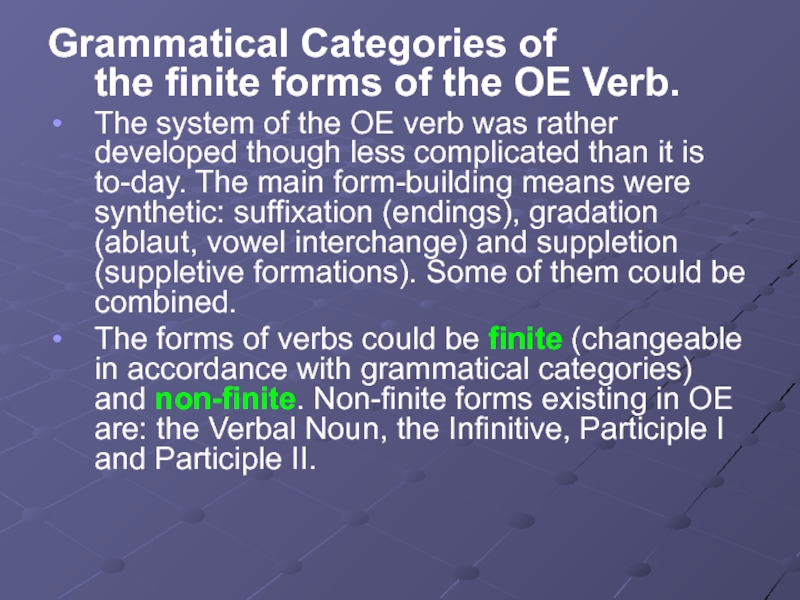







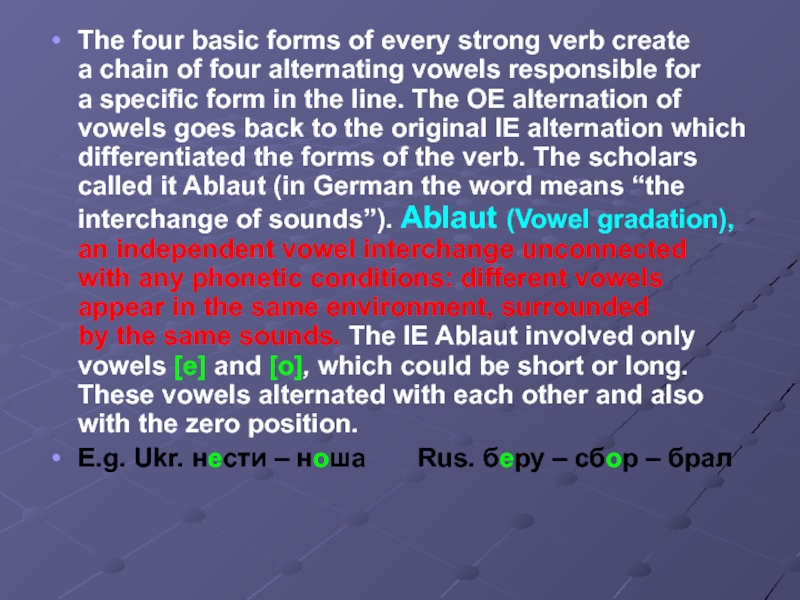
![KYIV NATIONAL LINGUISTIC UNIVERSITY The interchange between [e] and [o] was called qualitative (якісне чергування), The interchange between [e] and [o] was called qualitative (якісне чергування), Rus. бреду – брод the interchange](/img/thumbs/c5bcbbf7d075c0e3d2659e9806d7e0c3-800x.jpg)





